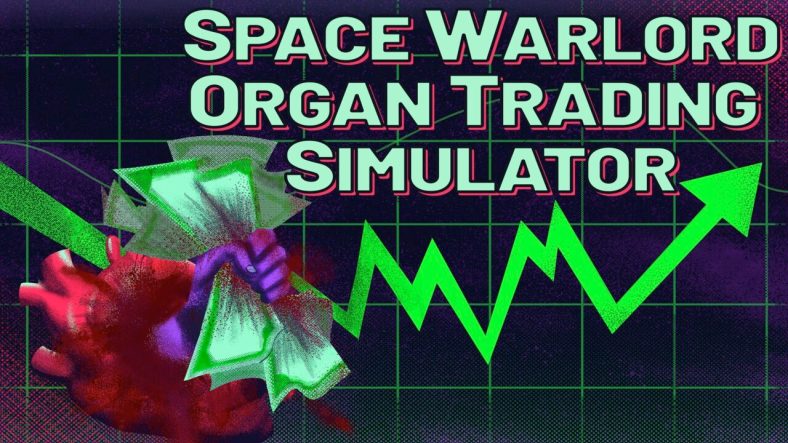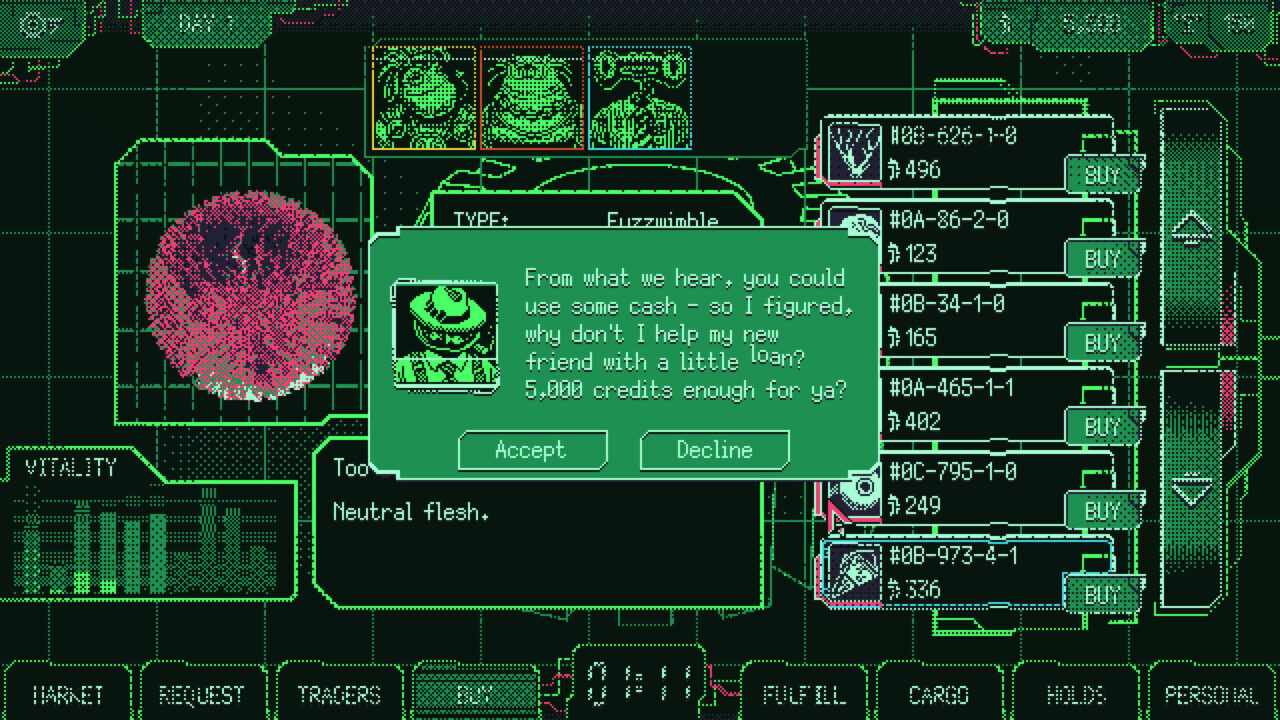I Chose to Figure Out the Price of a Human Body with Xalavier Nelson Jr.

One day I woke up, looked at my TV, and came to a sad realization: there is no PlayStation 5 next to that TV. I then looked at my body. It feels like I have a lot of unnecessary body. The thought then hit me: what if I sold some of my body parts to fund a PlayStation 5? For that, I needed an expert. Someone who has studied the human body and knows how much value it has. I turned to Xalavier Nelson Jr., the Director of the upcoming Space Warlord Organ Trading Simulator. He seemed like the exact expert I needed.
“The first thing you got to know about the human body: the price of anything is worth whatever someone is able to pay for it,” Nelson informed me. “Which has been a problem for me personally, because I have to figure out how the economy of a future that is mainly dominated by aliens and extraterrestrial presences, at least from a human perspective, would value the various organs inside a human body. What would they think is important?”
I had the right man for the job.

Before anything else, a brief explanation of Space Warlord Organ Trading Simulator (which, because that is a lot of words to type, will be known as SWOTS from here on out.) In SWOTS you will buy and sell organs on the intergalactic black market, often to and from aliens. To buy these things they use space credits. First, we had to figure out how much space credits are worth in USD, and according to Nelson the answer to that was 1SC = $2.43. This was made very clear to me that it was “not counting interstellar treaties that manage its sale regulation and overall universal nature.”
Next, it was made clear that all the prices here are base prices. However, that doesn’t mean they’re always going to be that price. Everything in SWOTS is constantly shifting in price, much like an actual market. Or, to use the ever-entertaining words of Nelson himself, the market is “a beautiful shifting boy.” The goal of the market is to constantly give you new problems to deal with as you try to sell your organs. However, for the purpose of the ever-important question of “can I buy a PlayStation 5 with my human body?” we decided it was best to just use the base prices. Obviously, prices will fluctuate depending on what the free market is willing to pay.

Hilariously, the market isn’t the only whims changing the value of organs. When the bladder first came up Nelson valued it at 86SC. This was then followed by a several-second pause before he admitted that seemed wrong and raised the value to 317SC. The reason? During our talk, Nelson’s entire worldview on the bladder changed. “I went from ‘oh it has pee in it’ to thinking it’s one of the most important organs in the human body. But you have to ask, am I wrong?” I’m not sure if Nelson was asking if he was actually wrong, or if this was a desperate plea to reassure him, as if the task of pricing every bit of flesh inside a human body had finally caused his sense of value, both the literal and metaphorical, to snap. I chose to tell him he was correct. It meant I could sell less of my body for the PlayStation 5.
Unfortunately, my plan backfired. Halfway through the list, Nelson’s worldview on the bladder changed again. He chose to “bump it down for its hubris,” not amused that the bladder was as important as it thought it was. “It’s basically a balloon,” Nelson explained of his new decision. “That’s not going to be hard to replace. We’ll have artificial bladders in the future, I’m sure.” While the new price of 167SC meant it was still above its base value, a small win, it was nowhere near what it once was.
Nelson isn’t the only one with a grip on the market though. When he brought up the large intestine he told me it was valued at 125SC. That seemed low and I had to inquire as to why. “It’s obnoxious,” Nelson carefully explained, comparing the organ to a frat boy slamming kegs of beer. “If there’s one thing I want people to know about me coming away from this interview, it’s that I think the large intestine ain’t shit.” At this point I decided to share a Cool Organ Fact with Nelson: large intestines don’t need to be put back a certain way in your body because they wiggle themselves back into shape. After several seconds of silence, I was informed that the value of the large intestine would be slightly raised because it “turns out they’re eldritch creatures.” I had achieved my goal in one small way, successfully manipulating the market in my favor. I went and googled terms about market manipulation so I could describe this and sound smart, but I understood none of them. We’ll just call this a pump and dump.

Finally, one organ stood out to me: the human soul. I couldn’t help but satisfy my curiosity and had to ask Nelson if the soul is actually an organ. “Sam,” Nelson said, with what I believe was an extreme mix of pain, anguish, and disappointment. “This is an entire f***ing rabbit hole. Do you really want to open this door?” I decided this wasn’t a door I was ready to open, not yet anyway. The soul can be an organ if it wants. Who am I to question it?
With all that said and done, and without further ado, here is the value of every human body part in SWOTS as of March 8th, 2021, when this interview took place. As you have seen, these values are very likely to change, not just when the market demands it, but also when someone on Strange Scaffold’s team learns a new Cool Organ Fact.
- Thyroid, 120SC ($291.6)
- Adrenal Glands, 500SC ($1,215)
- Bladder 167SC ($381.51)
- Soul, 810SC ($1,968.30)
- Stomach, 520SC ($1,263.60)
- Nerve Cluster 585SC x 12 ($17,085.60)
- Pancreas 470SC ($1,142.10)
- Large Intestine 140SC ($340.20)
- Small Intestine 169SC ($410.67)
- Eyeball 250SC x 2 ($1,215)
- Spleen 386SC ($937.98)
- Appendix 220SC ($486)
- Larynx 400SC ($972)
- Gall Bladder 180SC ($437.4)
- Brain 400SC ($972)
- Lung 500SC x 2 ($2,439)
- Kidney 400SC x 2 ($1,944)
- Liver 350SC ($850.50)
The total? The human body in SWOTS is currently worth $34,352.46 before the market has its way. For ease of use, Nelson and I agreed to round this up to $34,400. That’s quite a bit of money. So I achieved my goal: in selling chunks of my human body I could indeed achieve a PlayStation 5. How many PlayStation 5’s? Well, I did some quick napkin math and realized the answer was 69 of them. At this point, Nelson chose to give me a standing ovation. I am not joking. Unfortunately, it did come with the poison pill in that you had to get 68 disc PlayStation 5’s, and a single digital-only one. If you chose to go all digital-only PlayStation 5’s, you could get 86 of them.

We considered adding a new organ to the game that would be just enough to push us to exactly 69 disc PlayStation 5s. Some that we considered included eardrums, bone marrow, skin, tonsil, tongue, and testicles. None of those seemed particularly valuable, which makes them a good filler for a little bit more money.
What else could you get? $34,400 is quite a bit of money. I figure maybe I want some video games to go with my PlayStation 5. At $15 each, you could buy 2,293 copies of The Quiet Man. Want to get a little fancier? At $40 a pop, you can grab exactly 860 copies of Fast & Furious: Crossroads. Maybe, to reward Nelson with such a great interview, I wanted a few copies of games he worked on. Several of his games, including Cellular Harvest, Can Androids Pray, and Dread X Collection all cost $7. You can get 4914 copies of a single game, or spread the love around. Let’s say you wanted to reward Sam for doing such an amazing interview? If Nelson sold his organs then he could get 3,440 copies of Dread X Collection 3, the game I did QA work on.
Not saying you have to Nelson, but it would be nice.

It is, however, not infinite money. Nelson looked up the price of a Black Lotus card from Magic: The Gathering, a rather infamously expensive card. It sold for $511,100 at an auction, in flawless condition and signed by the artist. Even one that isn’t in flawless condition and signed by the artist still costs over $100,000. You’d have to harvest at least 3 bodies for that, if not more. I also discovered a sealed copy of Super Mario Brothers 3 selling for $156,000, so that too is off the table. We also debated if you could buy the IP for The Quiet Man. While we weren’t sure what Square Enix was charging for the IP, we settled that one body is not enough. “The Quiet Man has an enduring cultural impact.” Nelson reasoned. If it doesn’t yet, it will.
Besides buying things, what other takeaways did we get from this? “You can understand why Frankenstein dug up bodies,” Nelson explained. “This gets expensive really quickly.” I admitted that the conversation made me rather done with my human body, and I was ready to take a robot one. Nelson did not that this would actually be an awful idea because “Imagine you had a robot body and the only way to repair or upgrade yourself was to use the exact same thing people used to get cryptocurrency. It gets real bad real fast.” Cryptocurrency: not just ruining the environment, but also ruining my dream of becoming a robot. Finally, on the subject of SWOTS itself, Nelson simply left it at “This game is still finding new ways to horrify me.”
To end this, I don’t think there is any better quote than one Nelson gave me. “Here at Strange Scaffold we value the human body.” I asked him if he meant literally.
“Unfortunately.”
Categorized:Editorials Interviews

